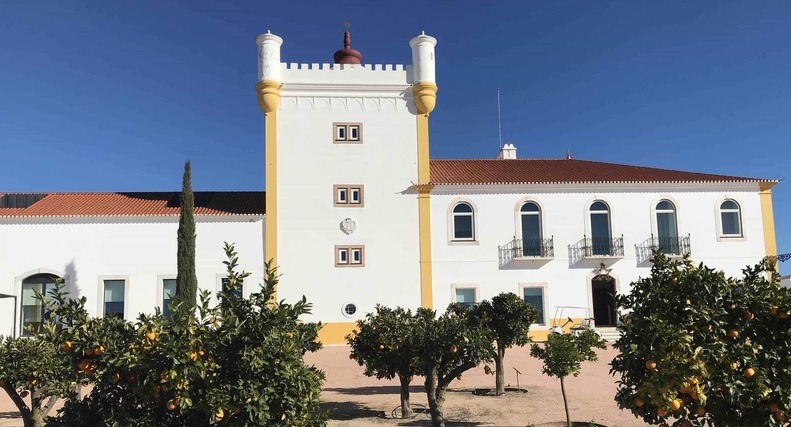
The Romans left a long legacy in bricks and mortar the length and breadth of Europe through their roads, bridges and aqueducts. But more than two thousand years later, their other great lingering legacy is wine – not something they invented, but something they embraced, developed and made their own.
Just like the technology company Apple when they launched the iPod and the iPhone – existing technology redesigned and mass produced… and which also changed the world.
When it comes to wine, one might call the Romans the Apple of the ancient civilisations.
Portugal is thought to have had the first vines courtesy of the Tartessians in 2000BC, and the first winemaking by the Phoenicians from around 800BC. But the Romans arrived in four hundred years later and left behind some pretty impressive evidence of the lifestyle they built around the grape and their worship of Bacchus, the god of wine.
There are few better examples in Portugal than the Torre de Palma villa where the Basilii family lived for nearly five centuries drinking wine, breeding horses and building spa baths.
Roman remains were first found on the Alentejo estate in Monforte in 1947 and archaeologists uncovered figurative mosaics so famous they now reside at a national museum in Lisbon.
One portrays five champion Lusitanian horses, first bred in this part of Portugal, while others represent Bacchus and the Mosaic of the Muses – nine women who now decorate one of the reserve wines produced at Torre de Palma today. Literally built upon the legacy of the family who lived here between the first and the fifth centuries, the site is now a luxurious wine hotel surrounded by vines and dedicated to the same values.
“What the Romans did then is what we do today,” said Luísa Rebelo, Torre de Palma’s general manager, and daughter of the Portuguese couple who bought the rundown property in 2008 and set about restoring it. “The Basiliis owned many hectares of land and had certain traditions like winemaking, olive oil making and breeding horses. What we tried to do here is to recreate the lifestyle of the Romans, in the winemaking, in the gastronomy, also in the spa, the horse breeding and horse riding.”
“So it’s pretty much the great pleasures of life, to eat, to drink and to enjoy the nature,” Luísa Rebelo said. Today Torre de Palma has a wonderfully echoing cathedral of a wine cellar designed by the Portuguese architect João Mendes Ribeiro, complete with its own God of Wine.
Duarte de Deus is the head winemaker who works with “seven hectares and seven different grape varieties” – all of them indigenous Portuguese varieties. He says the philosophy of Torre de Palma is small batch, limited editions, of high quality wines. At harvest time guests are invited to crush the grapes under foot in beautiful lagars made of the famous pink marble from nearby Estremoz.
“Deus means God, so I’ve said that I’m a god of wine,” joked the new generation Portuguese winemaker who believes wholeheartedly in Portugal’s native grapes, thinking people are now looking to explore wines and grapes they haven’t tried before.
The white grapes are Arinto, Antão Vaz and Alvarinho, while the reds are Aragonez, Touriga Nacional, Alicante Bouchet and Tinta Miúda – the latter an unusual variety which Duarte de Deus says was brought to Portugal 400 years ago. “Tinta Miúda gives freshness to the red wines – it gives the salt and pepper to that special wine, you know, that special touch. It’s really elegant.”
The Roman archaeological site is a short stagger from the renovated farm-building rooms and an award-winning fine-dining Palma restaurant, but is just one part of this property’s long history. Centuries of Islamic rule under the Moors followed the Romans and the Visigoths, then Christian reconquests from the twelfth century led to Portuguese dynasties which paved the way to the expansive period of ocean-going discoveries.
Torre de Palma’s centrepiece tower on the main building dates back to 1338 when the Portuguese Crown took ownership of the estate for 500 years. In private hands from 1863, its agricultural land provided work for the surrounding villages until the 1974 revolution when it came under collective ownership, fell into bankruptcy and then into ruin while its ownership was disputed for years in court.
And so the Rebelo Family stepped in, rebuilt the property and put Roman values back at the heart of the estate. Now a Design Hotel, with interiors by Rosarinho Gabriel, the rooms are fabulously coloured and varied, the spa is airy and relaxed, and the meals are beautifully crafted, and best enjoyed with wine: a touch of salt and pepper.
Alastair Leithead was a guest of the Torre de Palma wine hotel, located near Monforte, north of Estremoz in the Alentejo. He writes an occasional blog about Portuguese wine called The Big Portuguese Wine Adventure
